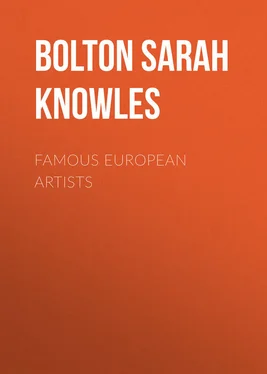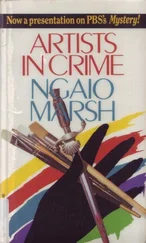Sarah Bolton - Famous European Artists
Здесь есть возможность читать онлайн «Sarah Bolton - Famous European Artists» — ознакомительный отрывок электронной книги совершенно бесплатно, а после прочтения отрывка купить полную версию. В некоторых случаях можно слушать аудио, скачать через торрент в формате fb2 и присутствует краткое содержание. ISBN: , Жанр: foreign_prose, foreign_antique, foreign_language, на английском языке. Описание произведения, (предисловие) а так же отзывы посетителей доступны на портале библиотеки ЛибКат.
- Название:Famous European Artists
- Автор:
- Жанр:
- Год:неизвестен
- ISBN:http://www.gutenberg.org/ebooks/39380
- Рейтинг книги:5 / 5. Голосов: 1
-
Избранное:Добавить в избранное
- Отзывы:
-
Ваша оценка:
- 100
- 1
- 2
- 3
- 4
- 5
Famous European Artists: краткое содержание, описание и аннотация
Предлагаем к чтению аннотацию, описание, краткое содержание или предисловие (зависит от того, что написал сам автор книги «Famous European Artists»). Если вы не нашли необходимую информацию о книге — напишите в комментариях, мы постараемся отыскать её.
Famous European Artists — читать онлайн ознакомительный отрывок
Ниже представлен текст книги, разбитый по страницам. Система сохранения места последней прочитанной страницы, позволяет с удобством читать онлайн бесплатно книгу «Famous European Artists», без необходимости каждый раз заново искать на чём Вы остановились. Поставьте закладку, и сможете в любой момент перейти на страницу, на которой закончили чтение.
Интервал:
Закладка:
In 1504, Da Vinci's father died, and the artist became involved in lawsuits with the other twelve children, who seem to have disputed his share in the property.
At this time Leonardo made drawings for the raising of the Church of San Giovanni (the Baptistery), and the placing of steps beneath it. "He supported his assertions with reasons so persuasive that while he spoke the undertaking seemed feasible, although every one of his hearers, when he had departed, could see for himself that such a thing was impossible." They could not understand that they had a genius in their midst some centuries in advance of his age. He made three bronze figures over the portal of the Baptistery, "without doubt the most beautiful castings that have been seen in these latter days."
Tired of lawsuits, and his ineffectual efforts toward the raising of the Baptistery, he gladly went back to Milan, having been invited thither by Maréchal de Chaumont, the French governor, after an absence in Florence of six years. He seems to have been straitened in circumstances, for he had but thirty crowns left, and of these he generously gave thirteen to make up the marriage portion of the sister of his beloved Salaï.
For seven years during this second sojourn in Milan, he was prosperous and happy. He built large docks and basins, planned many mills, enlarged and improved the great Martesan canal, two hundred miles long, "which brings the waters of the Adda through the Valtellina and across the Chiavenna district, contributing greatly to the fertility of the garden of Northern Italy," and painted several pictures. "La Monaca," now in the Pitti Palace, is the half-length figure of a young nun. Taine says, "The face is colorless excepting the powerful and strange red lips, and the whole physiognomy is calm, with a slight expression of disquietude. This is not an abstract being, emanating from the painter's brain, but an actual woman who has lived, a sister of Mona Lisa, as complex, as full of inward contrasts, and as inexplicable."
"Flora," a beautiful woman in blue drapery, holding a flower in her left hand, believed by many to be a portrait of Diana of Poitiers, is at the Hague, where the Hollanders call it "Frivolity" or "Vanity." Leda, the bride of Jupiter, with the twins, Castor and Pollux, "playing among the shell-chips of their broken egg," is also at the Hague.
Probably the celebrated La Vierge aux Rochers ("The Virgin among the Rocks") was painted at this time. Of this Théophile Gautier says, "The aspect of the Virgin is mysterious and charming. A grotto of basaltic rocks shelters the divine group, who are sitting on the margin of a clear spring, in the transparent depths of which we see the pebbles of its bed. Through the arcade of the grotto, we discover a rocky landscape, with a few scattered trees, and crossed by a stream, on the banks of which rises a village. All this is of a color as indefinable as those mysterious countries one traverses in a dream, and accords marvellously with the figures. What more adorable type than that of the Madonna! it is especially Leonardo's, and does not in any way recall the Virgins of Perugino or Raphael. Her head is spherical in form; the forehead well developed; the fine oval of her cheeks is gracefully rounded so as to enclose a chin most delicately curved; the eyes with lowered eyelids encircled with shadow, and the nose, not in a line with the forehead, like that of a Grecian statue, but still finely shaped; with nostrils tenderly cut, and trembling as though her breathing made them palpitate; the mouth a little large, it is true, but smiling with a deliciously enigmatic expression that Da Vinci gives to his female faces, a tiny shade of mischief mingling with the purity and goodness. The hair is long, loose, and silky, and falls in crisp meshes around the shadow-softened cheeks, according with the half-tints with incomparable grace."
This picture was originally on wood, but has been transferred to canvas. There are three pictures of this scene; the one in the collection of the Duke of Suffolk is believed to be the original, while that in the Louvre is best known.
Of the Virgin seated on the knees of St. Anne, now in the Louvre, Taine says, "In the little Jesus of the picture of St. Anne, a shoulder, a cheek, a temple, alone emerge from the shadowy depth. Leonardo da Vinci was a great musician. Perhaps he found in that gradation and change of color, in that vague yet charming magic of chiaroscuro, an effect resembling the crescendoes and decrescendoes of grand musical works."
"St. John the Baptist," in the Louvre, is one of the few pictures, among the many attributed to Leonardo, which critics regard as authentic. "St. Sebastian," now in the Hermitage in St. Petersburg, was purchased by the Tsar of Russia in 1860, for twelve thousand dollars.
When the French were driven out of Lombardy, Da Vinci left Milan, in 1514, and, taking his devoted pupils, Salaï, Francesco Melzi, and a few others with him, started for Rome, whither Michael Angelo and Raphael had already gone. Leo X. was on the papal throne: he cordially welcomed him, and bade him "work for the glory of God, Italy, Leo X., and Leonardo da Vinci." However, the pope gave him very little to do. "The pontiff," says Vasari, "was much inclined to philosophical inquiry, and was more especially addicted to the study of alchemy. Leonardo, therefore, having composed a kind of paste from wax, made of this, while it was still in its half-liquid state, certain figures of animals, entirely hollow and exceedingly slight in texture, which he then filled with air. When he blew into these figures he could make them fly through the air, but when the air within had escaped from them they fell to the earth.
"One day the vine-dresser of the Belvedere found a very curious lizard, and for this creature Leonardo constructed wings made from the skins of other lizards, flayed for the purpose; into these wings he put quicksilver, so that when the animal walked the wings moved also, with a tremulous motion; he then made eyes, horns, and a beard for the creature, which he tamed and kept in a case; he would then show it to the friends who came to visit him, and all who saw it ran away terrified."
When the pope asked him to paint a picture, Leonardo immediately began to distil oils and herbs for the varnish, whereupon the pontiff exclaimed, "Alas! this man will assuredly do nothing at all, since he is thinking of the end before he has made a beginning to his work." It is supposed that Leonardo painted for Leo X. the "Holy Family of St. Petersburg," with the bride of Giuliano de Medici as the St. Catherine.
Louis XII. of France having died, the brilliant young Francis I. succeeded him January 1, 1515, and soon after won back Lombardy to himself in battle. At once Leonardo, who had been painter to King Louis while in Milan, joined himself to Francis, not wishing to remain in Rome. He was received by that monarch with the greatest delight, and given the Château of Cloux with its woods, meadows, and fish-ponds, just outside the walls of the king's castle at Amboise. Here he abode with his dear pupils, who were content to live in any country so they were with Da Vinci; and was allowed a pension of seven hundred crowns of gold and the title of Painter to the King.
He was sixty-three. He had done many great things, but now, with ease and every comfort, perchance his genius would be more brilliant than ever. When about this age, Michael Angelo had completed his wonderful statues in the Medici chapel, and later even painted his "Last Judgment" and planned the great dome of St. Peter's. But Leonardo, the versatile, luxury-loving, "divine Leonardo," no longer urged to duty by necessity, did nothing further for the world. He mingled in the gayeties of the court, walked arm in arm in his gardens with the beautiful Salaï, his long white hair falling to his shoulders, and made a unique automaton for the great festivities of the conquering young king at Pavia, a lion filled with hidden machinery by means of which it walked up to the throne, and, opening its breast, showed it filled with a great number of fleurs-de-lis. He soon fell into a kind of languor that presaged the sure coming of death.
Читать дальшеИнтервал:
Закладка:
Похожие книги на «Famous European Artists»
Представляем Вашему вниманию похожие книги на «Famous European Artists» списком для выбора. Мы отобрали схожую по названию и смыслу литературу в надежде предоставить читателям больше вариантов отыскать новые, интересные, ещё непрочитанные произведения.
Обсуждение, отзывы о книге «Famous European Artists» и просто собственные мнения читателей. Оставьте ваши комментарии, напишите, что Вы думаете о произведении, его смысле или главных героях. Укажите что конкретно понравилось, а что нет, и почему Вы так считаете.












